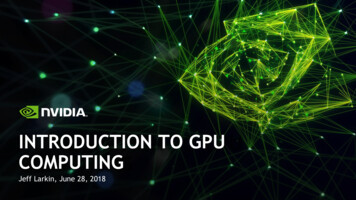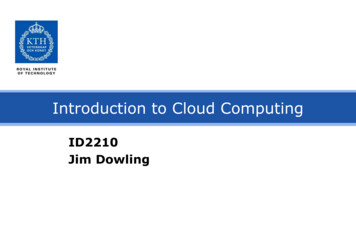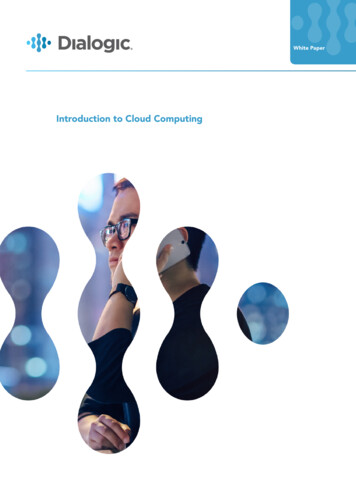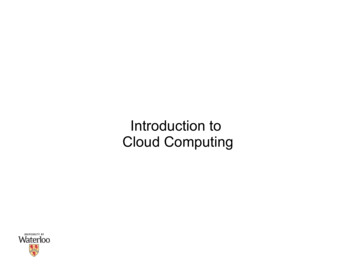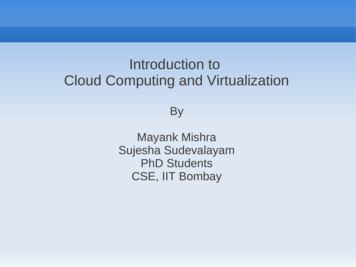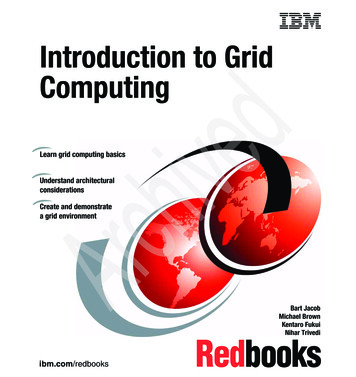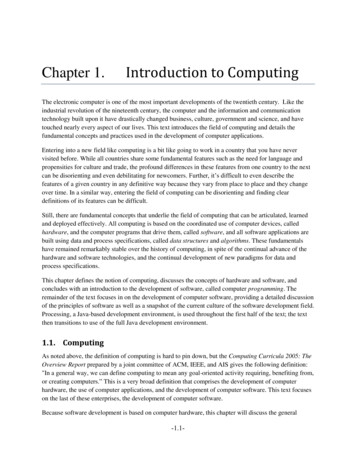
Transcription
Chapter 1.Introduction to ComputingThe electronic computer is one of the most important developments of the twentieth century. Like theindustrial revolution of the nineteenth century, the computer and the information and communicationtechnology built upon it have drastically changed business, culture, government and science, and havetouched nearly every aspect of our lives. This text introduces the field of computing and details thefundamental concepts and practices used in the development of computer applications.Entering into a new field like computing is a bit like going to work in a country that you have nevervisited before. While all countries share some fundamental features such as the need for language andpropensities for culture and trade, the profound differences in these features from one country to the nextcan be disorienting and even debilitating for newcomers. Further, it’s difficult to even describe thefeatures of a given country in any definitive way because they vary from place to place and they changeover time. In a similar way, entering the field of computing can be disorienting and finding cleardefinitions of its features can be difficult.Still, there are fundamental concepts that underlie the field of computing that can be articulated, learnedand deployed effectively. All computing is based on the coordinated use of computer devices, calledhardware, and the computer programs that drive them, called software, and all software applications arebuilt using data and process specifications, called data structures and algorithms. These fundamentalshave remained remarkably stable over the history of computing, in spite of the continual advance of thehardware and software technologies, and the continual development of new paradigms for data andprocess specifications.This chapter defines the notion of computing, discusses the concepts of hardware and software, andconcludes with an introduction to the development of software, called computer programming. Theremainder of the text focuses in on the development of computer software, providing a detailed discussionof the principles of software as well as a snapshot of the current culture of the software development field.Processing, a Java-based development environment, is used throughout the first half of the text; the textthen transitions to use of the full Java development environment.1.1. ComputingAs noted above, the definition of computing is hard to pin down, but the Computing Curricula 2005: TheOverview Report prepared by a joint committee of ACM, IEEE, and AIS gives the following definition:"In a general way, we can define computing to mean any goal-oriented activity requiring, benefiting from,or creating computers.‖ This is a very broad definition that comprises the development of computerhardware, the use of computer applications, and the development of computer software. This text focuseson the last of these enterprises, the development of computer software.Because software development is based on computer hardware, this chapter will discuss the general-1.1-
nature of computer hardware and its relationship to software as a way to prepare students for softwaredevelopment. The authors hope that this text will engage a new generation of software developersincluding not only the mathematically and scientifically inclined students commonly found inprogramming courses, but also a new generation of students from the arts and humanities who are findingthat computing is as relevant to their fields as it has ever been in the sciences.1.2. HardwareThe term computer dates back to the 1600s. However, until the 1950s, the term referred almostexclusively to a human who performed computations. For human beings, the task of performing largeamounts of computation is one that is laborious, time consuming, and error prone. Thus, the human desireto mechanize arithmetic is an ancient one.One of the earliest devices developed for simplifying humanarithmetic was the abacus already in use in ancientMesopotamia, Asian, Indian, Persian, Greco-Roman, and MezoAmerican societies and still in use today in many parts of theworld. Comprised of an organized collection of beads or stonesmoved along rods or in grooves, an abacus is, like the moderncomputer, a ―digital‖ arithmetic machine, in that its operations mimic the changes in digits that occurwhen humans do basic arithmetic calculations. However, not all of these abacus systems used decimal –base-10 – numerals; some of these societies used base-16, base-20, orbase-60 numeral systems.The young French mathematician Blaise Pascal (1623-1662) inventedone of the first gear-based adding machines to help with the enormousamount of calculations involved in the computing of taxes.Operationally, the decimal version of the ―Pascaline‖ had much incommon with a genre of calculators that were commonly used bygrocery store shoppers in the U.S. and elsewhere during the 1950s and1960s.In 1822, English mathematician Charles Babbage (1792-1871)unveiled the first phase of his envisioned ―Difference Engine‖ whichalso used ten-position gears to represent decimal digits. It was capableof performing more complex calculations than the basic arithmetic ofan adding machine like the Pascaline. However, the engineering of theDifference Engine became so complicated that, for this and otherreasons, Babbage abandoned the project.There are two main difficulties here, illustrating two key concepts incomputing. First, these devices were ―mechanical‖ – i.e., they weredevices that required physically moving and interconnected parts.Such a device is almost certain to be slower, more prone to failure, andmore difficult to manufacture than a device that has no moving parts.-1.2-
In contrast, ―electronic‖ devices such as vacuum tubes of the sort used in early radios have, by definition,no moving parts.Thus, one of the earliest electronic digital computers, the ENIAC represented each decimal digit not witha 10-state mechanical device like a gear but, rather, with a column of 10 vacuum tubes which couldelectronically turn on and off to represent the 0-9 counting sequence of a decimal digit without requiringany physical movement.Engineered by J. Presper Eckert and John Mauchly at theUniversity of Pennsylvania from 1943 to 1946, the 30-tonENIAC required 18,000 vacuum tubes, consuming enormousamounts of electrical power for its day. This is largely becauseENIAC required 10 vacuum tubes to represent each decimaldigit.In contrast, the first electronic digital computer developed byJohn Atanasoff and Clifford Berry at Iowa State University from1937-1942, like all electronic digital computers today, used a binary– i.e., Base-2 numeral system.Decimal digits are based on powers of 10, where every digit onemoves to the left represents another power of 10: ones (100), tens(101), hundreds (102), thousands (103), etc. Thus, the decimalnumber ―two hundred fifty-five‖ is written as ―255,‖ conceiving ofit arithmetically as the sum of 2 hundreds, 5 tens, and 5 ones. Thus,to store this number, ENIAC would only have to turn on 3 vacuumtubes, but there are still a total of 30 vacuum tubes required just torepresent all of the possibilities of these three digits.On the other hand, binary digits – also known as ―bits‖ -- arebased on powers of 2, where every digit one moves to the leftrepresents another power of 2: ones (20), twos (21), fours (102),eights (103), sixteens (104), etc. Thus, in binary, the numbereighteen would be written in Base-2 as 10010, understoodarithmetically as the sum of 1 sixteen, 0 eights, 0 fours, 1 two, and 0 ones:Likewise, the number ―two-hundred fifty-five‖ would be written in binary numerals as 11111111,conceived arithmetically as the sum of 1 one-hundred twenty eight, 1 sixty-four, 1 thirty-two, 1 sixteen, 1eight, 1 four, 1 two, and 1 one :-1.3-
Why on earth would computer engineers choose to build a machine to do arithmetic using such a cryptic,unfamiliar form of writing numbers as a binary, Base-Two numeral scheme? Here’s why.In any digital numeral system, each digit must be able to count up to one less than the base. Thus, in thecase of the Base-10 system, counting sequence of each decimal digit runs from 0 up to 9, and then back to0. To represent a decimal digit, then, one must be able to account for all 10 possibilities in the countingsequence, 0 through 9, so one must either use a device with ten possible states, like the ten-position gearused in the Pascaline, or ten separate devices, like the ten separate vacuum tubes used for each digit in theENIAC.However, the binary numeral system is Base-2. Thus, given that its digits also need only to be able tocount as high as one less than the base, this means that the counting sequence of each binary digit runsfrom 0 only up to 1, and then back again to 0 already. In other words, whereas ten different numbers canappear in a decimal digit, 0 through 9, the only number that will ever appear in a binary digit is a 0 or a 1.Thus, rather than having to account for the 10 possibilities of a decimal digit, one can represent a binarydigit with only a single device that has two possible states. For example, one could represent each binarydigit with a simple on/off switch, where the ―on‖ position represents a 1 and the ―off” position representsa 0:Similarly, in the Atansoff-Berry Computer, each binary digit could be represented with a single vacuumtube. Thus, the number ―eighteen‖ could be represented with only 5 vacuum tubes, instead of the 20 theENIAC required:-1.4-
Likewise, the number ―two hundred fifty-five‖ could be represented with only 8 vacuum tubes, insteadof the 30 that ENIAC required:Thus, in exchange for the cryptic unfamiliarity of binary representation,computer engineers gained an efficient way to make electronic digitalcomputers through the use of two-state electronic devices.Just as radios with vacuum tubes were superseded by ―transistor radios‖beginning in the 1950s, so this ―first generation‖ of digital computers based onvacuum tubes eventually gave way to a ―second generation‖ that used thetransistor as an even faster—and considerably smaller – non-moving, on-offswitch for representing the 1 or 0 of a binary digit.1.2.1. ProcessorsIt is fairly easy to acquire a basic understanding of how a line of interlocking, 10-position gears canmimic the operations of decimal arithmetic. But it is far less obvious how an array of vacuum tubes ortransistors, used as electronic on-off switches, mimic the operations of binary arithmetic.One helpful analogy is that of a set of dominoes. Imagine a domino exhibition on a late-night talk show,where a domino champion sets up an elaborate maze of dominoes, knocks one of them over, and sets offan elaborate chain reaction of falling dominoes, lasting several minutes. Eventually, the sequence offalling dominoes reaches the end, and the last set of dominoes tumble over in a grand flourish. Similarly,imagine a set of dominoes on a table where there is a line of eight dominoes at one end, and another lineof eight dominoes at the other end, with a maze of other dominoes in between. If you were to go to theeight dominoes at one end and knock over some or all of them, this would set off a chain reaction offalling dominoes in the maze laid out until, eventually, this chain reaction stopped at the other end wheresome or all of those eight dominoes would be knocked over as a result of this chain reaction.-1.5-
There are some similarities here to the way a processor works. A domino, like atransistor, is a two state device: just as a transistor can be in either an on or offposition, a domino can be either standing up or lying down. Thus, like any othertwo state device, a domino or transistor can model the two possibilities that existfor a binary digit: a 0 or a 1. For example, we could think of a domino that isstanding up as a 1, and a domino that is lying down as a 0. Knocking over some orall of the dominoes in that first row of eight, then, is like "inputting" an eight digitbinary number into this domino "machine."In a sense, this binary number is an ―instruction‖ to this machine, specifying theparticular set of chain reactions of these two-state devices that should take place.And, when this chain reaction is completed, and some or all of the eight dominoes atthe other end are knocked over, it is as if this domino machine has "output" an eightdigit binary number.-1.6-
This domino analogy provides many similarities to the way a processor ―chip‖ made up of transistorsoperates. Binary numbers representing a basic arithmetic operation -- add, subtract, multiply, divide -flow into a processor in the form of "high" or "low" electrical signals on wires. This sets off a chainreaction among the literally millions of microscopic transistors, on-off switches, that make up theprocessor. When the chain reaction has completed, a binary number representing the result flows out onthe wires leading away from the processor. The maze of transistors within the processor is designed sothat output of the chain reaction is the one that represents the "right answer" for the input arithmeticinstruction. The Intel 8088, the processor used in the original IBM PC, in fact, was an 8-bit processor,meaning that, in the course of each ―instruction cycle,‖ an 8-digit binary number would be input, the―processing‖ (chain reaction) would take place, and a resulting 8-digit binary number would be output.Thus, even today, a modern electronic digital computer is still, at the core of its hardware, a machine thatperforms basic arithmetic operations. More specifically, it is a machine that mimics or models the waythat digits change when humans do basic arithmetic. What is remarkable about the way that today'scomputers model arithmetic is their extraordinary speed in doing so. Today's microprocessors aretypically 32 bits or higher, meaning that their instructions are comprised of binary numbers that are 32 ormore digits. Their instruction cycles are described in "gigahertz," meaning that such processors canperform literally billions of instruction cycles every second.1.3. SoftwareThe arithmetic power that such hardware provides is useless unless it can be put into service performinguseful calculations in correct sequences involving meaningful numbers. It is computer software thatprovides such meaningful, useful direction. Indeed, it is the rise of software that has enabled computersto evolve from mere number crunchers into technologies that now enrich so many areas of human life.Consider the analogy of computing one's taxes. A calculator can certainly be of assistance in this process,speeding up and improving the accuracy of the arithmetic that is involved. However, a calculator cannotcompute your taxes for you. Rather, it is the tax form that specifies which arithmetic operations should beperformed, in what order, and with what numbers. In this sense, a tax form has much in common with a-1.7-
computer program, which is a also a defined sequence of actions involving correct information that, whenperformed, produces a desired result. For example, in the case of the tax software that is widely availabletoday, the computer program is modeled after the program for human action that is prescribed by the taxform.Charles Babbage, already identified as a key figure in the historyof computer hardware, is also a key figure in the history ofsoftware. After giving up on the ―Difference Engine,‖ Babbagebegan work on a much more sophisticated machine that he calledhis ―Analytical Engine.‖ The operation of this machine was to befar more versatile and automatic than his earlier invention. Inhardware terms, Babbage conceived of a machine built to performthe basic operations of arithmetic upon numeric digits – i.e., acalculator. However, borrowing a technology from the automated―Jacquard‖ looms that began to appear during the early 1800s,Babbage planned to feed into his Analytical Engine sequences of metal cards with holes punched intothem. Instead of being used to define a sequence of threads to incorporate into a particular weave, thepunched cards would be used to define a sequence of basic arithmetic operations for the AnalyticalEngine to perform that, together, achieved a desired mathematical result. In other words, unlike previouscalculating machines, the Analytical Engine would be programmable: just as a single automated loomcould perform different weaves simply by switching sets of punched cards, so Babbage’s AnalyticalEngine would be able to switch between different mathematical computations simply by changing the setof punched cards. To a remarkable degree, the Analytical Engine anticipated the fundamental"architecture" of the modern electronic computer in that it was organized into the four primarysubsystems of processing, storage, input, and output.Ada Lovelace, daughter of Lord Byron, was one of the few people other thanBabbage who understood the Analytical Engine’s enormous potential. Shedescribed the similarity of Jacquard’s and Babbage’s inventions: ―TheAnalytical Engine weaves algebraic patterns just as the Jacquard loom weavesflowers and leaves,‖ in both cases, simply by performing a carefully devisedsequence of basic operations. Lovelace designed and wrote out demonstrationsof how complex mathematical computations could be constructed entirely fromsequences of the basic set of arithmetic operations of which the AnalyticalEngine would be capable. Ada Lovelace is often deemed to be ―the firstprogrammer,‖ and her work certainly has much in it that recommends this titlefor her – even more, in fact, than is usually acknowledged.In her writings, Lovelace identified that one of the key characteristics of a computer program is itscarefully sequential nature. Mathematicians often use the term "algorithm" to refer to a specific sequenceof operations that, if performed, will produce a certain desired result. Accordingly, one of the keyactivities of computer programming is often said to be "algorithm design," whereby a certain process issuccessfully broken down into a sequence that is comprised entirely of operations that a computer is ableto perform. This notion of programming as designing a sequence of operations to accomplish somedesired result also matches well to what is sometimes called the ―procedural‖ paradigm of computerprogramming.-1.8-
Lovelace also noted that a good computer program is one that is general, in the sense that the designedsequence of operations should be able to ―be performed on an infinite variety of particular numericalvalues‖ rather than being designed to operate upon only a specific set of operands. For example, ratherthan designing a program to perform(2 x 10) - 5a program that is "general‖ would be one designed to take in any three numbers, multiply the first two,and then subtract the third number from the result. This illustrates what Lovelace described as operationsthat are "independent" from ―the objects operated upon.‖ In modern computing, this is often described interms of the separation that is maintained between the "data" and the operations upon that data.Lovelace also described what she called ―cycles‖ of operations, where a certain desired result could beachieved by performing a certain subset of operations repeatedly. In modern computer programming, thisis called a "loop." One simple illustration of this is the way that any multiplication operation5x4can also be achieved by repeatedly performing a single addition operation:5 5 5 5This remarkable capability of the computer to automatically perform cycles of operation, with the resultsbuilding upon each other, is part of the reason why Lovelace boldly claimed that such a machine would infact be able to perform computations that had not ever ―been actually worked out‖ previously by anyhuman. This also underscores an important aspect of programming that is sometimes overlooked:namely, that the process of programming seldom consists of the mere encoding in a programminglanguage of a fully envisioned idea of the software that was already completely worked out, conceptually.Rather, the process of programming is one that entails exploration, experimentation, discovery, creativity,and invention.Perhaps even more impressive is the degree to which Ada Lovelace foresaw that the applications ofcomputing would be well beyond science and mathematics. Lovelace carefully pointed out that theanalytical engine operated not upon actual numbers but, rather, upon symbols of numbers, and that ―theengine can arrange and combine‖ such symbols of numbers just as readily ―if they were letters or anyother general symbols.‖ In fact, said Lovelace, what is meant in this context ―by the word operation‖could refer to ―any process which alters the mutual relation of two or more things, be this relation of whatkind it may.‖ Thus, for Lovelace, part of the power of the computer is its ability to create and manipulatesymbolic representations of the many entities and ―great facts of the natural world.‖ However, Lovelacealso identifies the extraordinary ability of the computer to create symbolic representations of certainaspects of the relationships between facts, objects, and living things, and, through its manipulations ofthose representations, create models of ―those unceasing changes of mutual relationship which, visibly orinvisibly, consciously or unconsciously to our immediate physical perceptions, are interminably going onin the agencies of the creation we live amidst.‖ Thus, given this ―most general definition‖ of a computeras a manipulator of symbolic representations of facts, entities, and relationships, Lovelace suggested thatthe ―new, fast, and powerful language‖ that we now call computer ―programming‖ could potentially be ofuse not only to mathematics and science but to ―all subjects in the universe.‖-1.9-
As we now know, computers can do so much more than the kind of arithmetic computations that areinvolved in doing one's taxes. This is because computers have indeed motivated software programmers todiscover just how many actual and imaginary facts and entities can, to at least some degree, be modeled inthe form of symbols that can be manipulated in ways that mimic actions, processes, phenomena, andrelationships.1.3.1. Object-Oriented Programming and Personal ComputingIn certain ways, Lovelace anticipated a shift in conceptions of computer programming. She sawcomputing and programming as extending beyond the realm of numerical data and traditional notions ofalgebraic sequences of arithmetic operations. Instead, she saw programming as technology that enablesthe creation and manipulation of what we would now call computer ―models‖. This shift from a strictlyprocedural paradigm toward one that also allows for the option of what has come to be known as ―objectoriented programming‖ has virtual ―objects‖ with associated characteristics and actions as thefundamental ―building blocks‖ of software.Object-oriented programming (―OOP‖) emerged largely from attempts in the latter half of the 1970s todevelop a new generation of ―personal computers‖ and ―graphical user interfaces,‖ and the rapid rise inpopularity of these technologies beginning in the latter half of the 1980s was accompanied by a similarrise to prominence of the object-oriented notions of programming that enabled them.One of the first persons to use the term "personalcomputer" was Alan Kay who, over the courseof the 1970s, led a team at Xerox Corporation'sPalo Alto Research Center (PARC) in pursuit ofthe creation of a small, portable computer. Theenvisioned "Dynabook,‖ as it was called, bore aremarkable similarity to the "notebook"computers that would begin to appear twodecades later. One of the most striking featuresof the Dynabook was its "graphical userinterface" (GUI), which enabled users to interactwith this computer by selecting andmanipulating onscreen menus using a relativelyunknown new pointing device called a "mouse,‖ rather than requiring the user to memorize and typecryptic commands in the manner that had characterized the previous "command line interface" paradigm.The Dynabook's GUI also enabled the user to operate in multiple onscreen "windows‖ that could providedifferent views simultaneously. The data created and manipulated by the user was represented on thescreen in the form of interactive virtual "objects": passages of text, drawings, photographs, sounds andmusic, descriptive icons, and much more. Such a GUI was designed to create an interactive on-screenrepresentation of an environment for action that would be immediately recognized and easily manipulatedby the user. However, the ―Smalltalk‖ software system of the Dynabook was also a graphical objectoriented programming environment. The driving vision of Kay’s team was one in which Dynabook userswould begin by interacting with intuitive software created by others but, when they were ready, theywould also be able to examine and even change the defined characteristics and behaviors of the virtual"objects‖ that comprised these software programs. In fact, the goal was to design a version of the-1.10-
Smalltalk programming language that was so intuitive that even children using the Dynabook mighteventually decide to author their own software programs. Early tests with Palo Alto school children hadproven to be very promising in this regard.As part of an attempt to demonstrate the value of the Dynabookproject, an example of such a GUI was created that featured avirtual "desktop" designed to emulate the activities andworkspace typical of office work in a way that even such anemployee with no prior computer experience would findinteracting with the system to be an intuitive, productive, andenjoyable experience. This experiment failed to convince Xeroxexecutives; however, several years later in 1979, AppleComputer cofounder Steve Jobs saw a demonstration of thisGUI.The Apple II personal computer system, first introduced in1977, had, like other early ―microcomputer‖ systems,interacted with users via a command line interface. However,after seeing the PARC system, Jobs said that within ―tenminutes it was obvious to me that all computers would worklike this someday.‖ Jobs immediately set to work on creatingthe new generation of Apple computers that began when theMacintosh was introduced in January 1984. The graphicaluser interface of the Macintosh, as well as that of the Microsoft―Windows‖ operating system that was introduced a year later,bore much resemblance to the ―desktop‖ GUI developed at Xerox PARC.Like other early microcomputers, initially the Apple II was designed and marketed on the assumption thatusers would usually write their own software (probably using one of the introductory proceduralprogramming languages of that era, such as the widely-used ―BASIC‖). However, another key event hadtaken place in 1979, one that subsequently propelled the Apple II to heights of popularity that went farbeyond computer hobbyists and programmers.―VisiCalc,‖ a radically new and powerful ―spreadsheet‖software program that had been developed several yearsearlier for larger computer systems was successfully ―ported‖for use on the Apple II microcomputer system in 1979.VisiCalc is an example of what is called an ―application‖software program – an already-written software program thatis distributed for use by others. In fact, VisiCalc is often saidto be the Apple II’s ―killer app,‖ a term which has come torefer to an application of a new technology that serves to-1.11-
justify the adoption of that technology by a wide range of new users.1 The availability of a version of thehighly-regarded VisiCalc spreadsheet software for the Apple II – and, subsequently, for several othermicrocomputers, including those made by Atari and Commodore – served to convince many that theApple II was not a mere novelty device but, rather, was a bona fide computer with the potential forserious business and scientific use. Similarly, when IBM Corporation, in response to this sudden andrapid rise in the popularity of microcomputers in the late 1970s fueled largely by VisiCalc, rushed tointroduce a personal computer of it is own in 1981, the ―killer app‖ that convinced the most consumers topurchase the IBM ―PC‖ was, once again, a spreadsheet program: ―Lotus 1-2-3.‖Spreadsheet software provided novice computer users with the ability to undertake the kind ofcomputational operations on numerical and textual data that were so strongly associated with computerswithout having to learn what they would have viewed as a ―real‖ programming language. In fact,especially in light of the overall history of computing, it does not seem to be too much of a stretch tosuggest that spreadsheet software provided a new kind of computer programming environment. Noviceusers certainly found the designing of computations within spreadsheets to be much more intuitive thandoing so in standard programming languages. However, in retrospect, it seems unfortunate thatspreadsheet software itself came to be understood so strongly as the "application software,‖ rather thanconsidering such spreadsheet software to be a kind of programming environment, where the spreadsheetsthat this software system enabled one to create for use by others were considered to be the resultantapplication software. The fact that this did not take place perhaps reflects the larger shift in the publicunderstanding of the concept of "personal computing" that took place over the course of the 1980s, whereAlan Kay’s dream of a personal computer that was so graphical and so intuitive that even a child wouldbe able to write software programs for it was displaced by a conception of the personal computer as amachine that no one should have to learn to program.What seems to have been completely lost in the Apple’s and Microsoft's adaptations of PARC’sDynabook vision was the idea of enabling novice computer users not only to
1.1. Computing As noted above, the definition of computing is hard to pin down, but the Computing Curricula 2005: The Overview Report prepared by a joint committee of ACM, IEEE, and AIS gives the following definition: "In a general way, we can define computing to mean any goal-oriented act






